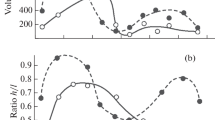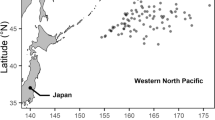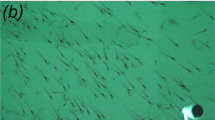Summary
-
1.
Methods for producing and analyzing long-term three-dimensional records of the positions of individuals within fish schools are described. Detailed analysis of internal structure and overall shapes of schools of three species which school to varying degrees are reported: Data from cod (Gadus morhua), a weak facultative schooler, saithe (Pollachius virens), a strong facultative schooler, and herring (Clupea harengus), an obligate schooler, are presented.
-
2.
Fish do not position themselves at random within schools (Figs. 1 and 2). This is shown to result from the maintenance of minimum approach distances between fish (Fig. 3). Comparison of the frequency of neighbors at different distances with that expected at random (Fig. 3), however, demonstrates that fish space themselves more regularly than one would expect if the structure resulted wholly from minimum approach distances.
-
3.
Herring and saithe are shown to swim at nearly but not exactly the same depth as their neighbors (Fig. 5). Neighbors are more-or-less equally common in all directions (bearings) around fish, although herring show some tendency toward taking up positions at 45° and 135°, the positions expected if school structure were a cubic lattice. School structure is present in a statistical sense only.
-
4.
Herring are shown to maintain proportionately larger interfish distances than do saithe or cod (Fig. 7). These results are discussed in terms of the body structure of the three species and the antipredator function of schooling. Shape of cod schools and, to a lesser degree, saithe schools, is shown to be highly variable. Herring schools, however, appear fairly constant in their external shape (Fig. 10).
-
5.
Factors affecting the structure of schools of saithe are studied. Increasing the number of fish in the school or the speed at which it is swimming results in smaller interfish distances (Figs. 8 and 9).
Similar content being viewed by others
References
Bateson, W.: The sense-organs and perceptions of fish: With remarks on the supply of bait. J. Mar. Biol. Assoc. UK 1, 225–256 (1889)
Blaxter, J.H.S.: Effect of change of light intensity on fish. Int. Counc. N. Atlantic Fish. Spec. Publ. 6, 648–661 (1965)
Breder, C.M., Jr.: Equations descriptive of fish schools and other animal aggregations. Ecology 35, 361–370 (1954)
Breder, C.M., Jr.: Studies on social groupings in fish. Bull. Am. Mus. Nat. Hist. 117, 397–481 (1959)
Breder, C.M., Jr.: Vortices and fish schools. Zoologica 50, 97–114 (1965)
Breder, C.M., Jr.: On the survival value of fish schools. Zoologica 52, 25–40 (1967)
Breder, C.M., Jr.: Fish schools as operational structures. Fish. Bull. 74, 471–502 (1976)
Cullen, J.M., Shaw, E., Baldwin, H.: Methods for measuring the 3-D structure of fish schools. Anim. Behav. 13, 534–543 (1965)
Cushing, D.H.: Observations on fish schools with the ARL scanner. J. Cons. Int. Expl., Mer. 170, 15–20 (1977)
Hamilton, W.D.: Geometry for the selfish herd. J. Theor. Biol. 31, 295–311 (1971)
Hemmings, C.C.: Olfaction and vision in fish schooling. J. Exp. Biol. 45, 449–464 (1966)
Hunter, J.R.: Procedure for analysis of schooling behavior. J. Fish. Res. Board Can. 23, 547–562 (1966)
Lythgoe, J.N.: Visual pigments and underwater vision. In: Light as an ecological factor. Bainbridge et al. (eds.), pp. 375–391. Oxford: Oxford University 1962
Keenleyside, M.: Aspects of schooling behavior in fish. Behavior 8, 83–248 (1955)
Major, P.F.: Predator-prey interactions in schooling fishes during periods of twighlight: A study of the silverside Pranesus insularium in Hawaii. U.S. Fish. Bull 75, 415–426 (1976)
Major, P.F., Dill, L.M.: The three-dimensional structure of airborne bird flocks. Behav. Ecol. Sociobiol. 4, 111–122 (1978)
Neill, S.R., St. J., Cullen, M.: Experiments on whether schooling by their prey affects the hunting behaviour of cephalopods and fish predators. J. Zool. 172, 549–569 (1974)
Nursall, J.R.: Some behavioral interactions of spottail shiner (Notropis hudsonius), yellow perch (Perca flavescens) and northern pike (Esox lucius). J. Fish. Res. Board Can. 30, 1161–1178 (1973)
Olst, J.C. van, Hunter, J.R.: Some aspects of the organisation of fish schools. J. Fish. Res. Board Can. 27, 1225–1238 (1970)
Parr, E.A.: A contribution to the theoretical analysis of the schooling behavior of fishes. Occas. Pap. Bingham. Ocean. Coll. 1, 1–32 (1927)
Partridge, B.L.: Sensory aspects of schooling. D. Phil. thesis, University of Oxford, p. 550 (1978)
Partridge, B.L.: The effect of school size on the structure and dynamics of minnow schools. Anim. Behav. 28, 68–77 (1980)
Partridge, B.L.: The structure and function of fish schools. Oxford: Oxford University (in press) (1980)
Partridge, B.L., Cullen, J.M.: A low cost interactive coordinate plotter. Behav. Res. Methods Instrum. 9, 473–479 (1977)
Partridge, B.L., Dawkins, R., Amlaner, C.: Voltage controlled oscillators: Inexpensive alternative to analogue-digital converters. Behav. Res. Methods Instrum. 10, 712–714 (1978)
Partridge, B.L., Pitcher, T.J.: Evidence against a hydrodynamic function for fish schools. Nature 279, 418–419 (1979)
Partridge, B.L., Pitcher, T.J.: The sensory basis of fish schools: Relative roles of lateral line and vision. J. Comp. Physiol. (in press) (1980)
Pielou, E.C.: An introduction to mathematical ecology. New York: Wiley 1969
Pitcher, T.J.: The 3-dimensional structure of schools in the minnow (Phoxinus phoximus). Anim. Behav. 21, 673–686 (1973)
Pitcher, T.J.: A periscopic method, for determining the 3-D positions of fish in schools. J. Fish. Res. Board Can. 32, 1533–1538 (1975)
Pitcher, T.J.: Sensory information and the organisation of behavior in a shoaling cyprinid fish. Anim. Behav. 27, 126–149 (1979)
Pitcher, T.J., Partridge, B.L.: Fish school density and volume. Mar. Biol. 54, 383–394 (1979)
Pitcher, T.J., Partridge, B.L., Wardle, C.S.: A blind fish can school. Science 194, 963–965 (1976)
Potts, G.V.N.: The schooling ethology of Lutianus monostigmata (pisces) in the shallow reef environment of Aldabra. J. Zool. 101, 223–235 (1970)
Radakov, D.V.: On the adaptive significance of shoaling of young coal fish (Pollachius virens) (in Russian). Vopr. Ikhtiol. 11, 69–74 (1958)
Radakov, D.V.: Schooling in the ecology of fish. Israeli Scientific Translation Series. New York: John Wiley and Sons 1973
Saetersdahl, G.: Review of the information on the behavior of gadoid fish. In: FAO conference on fish behavior, 1967. FR:FB (67) R-11. Bergen, pp. 201–215, 1967
Seghers, B.: Schooling behaviour in the guppy (Poecilia reticulata) an evolutionary response to predation. Evolution 28, 488–489 (1974)
Serebrov, L.I.: Relationship between school density and size of fish. J. Ichthyol. 15, 135–140 (1974)
Shaw, E.: Schooling in fishes: Critique and review. In: Development and evolution of behavior. Aronson, L., Tobach, E., Lehrman, D., Rosenblatt, J. (eds.), pp. 452–480. San Francisco: W.H. Freeman 1970
Shaw, E.: Schooling fish. Am. Sci. 66, 166–175 (1978)
Siegel, S.: Nonparametric statistics for the behavioral sciences. Tokyo: McGraw-Hill 1956
Sokal, R., Rohlf, F.: Biometry. San Francisco: W.H. Freeman 1969
Symons, P.E.: Spacing and density of schooling three spine stickle-backs and mummichog. J. Fish. Res. Board Can. 28, 999–1004 (1971a)
Symons, P.E.: Estimating distances between fish in an aquarium. J. Fish. Res. Board Can. 28, 1085–1086 (1971b)
Treisman, M.: Predation and the evolution of gregariousness. I. Models of concealment and evasion. Anim. Behav. 23, 779–800 (1975)
Wardle, C.S., Anthony, P.D.: Experimental methods used for the study of fish behaviour in large tanks. I.C.E.S., CM 1973/B:22 (1973)
Weihs, D.: Hydrodynamics of fish schooling. Nature 241, 290–291 (1973)
Weihs, D.: Some hydrodynamical aspects of fish schooling. In: Proc. Sym. Swimming and Flying in Nature. Pasadena, California, July 1974. Wu, T., Brokaw, C., Brennen, C. (eds.), vol. 2, pp. 703–718. New York: Plenum 1975
Williams, G.C.: Measurements of consociation among fishes and comments on the evolution of schooling. Publ. Mus. Mich. State Univ. Biol. Ser. 2, 349–384 (1964)
Author information
Authors and Affiliations
Additional information
This paper formed part of a thesis by BLP to the University of Oxford
Rights and permissions
About this article
Cite this article
Partridge, B.L., Pitcher, T., Cullen, J.M. et al. The three-dimensional structure of fish schools. Behav Ecol Sociobiol 6, 277–288 (1980). https://doi.org/10.1007/BF00292770
Received:
Accepted:
Issue Date:
DOI: https://doi.org/10.1007/BF00292770




